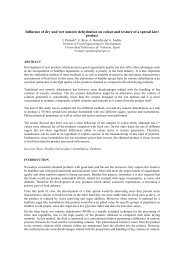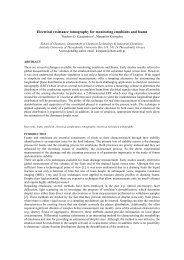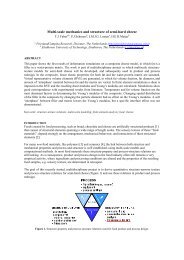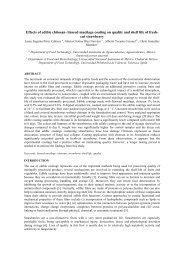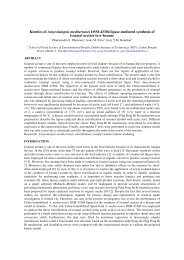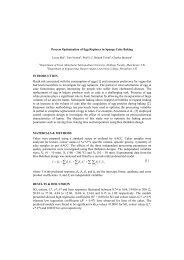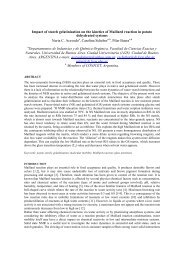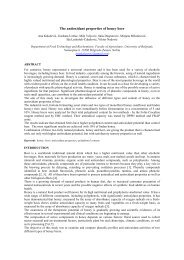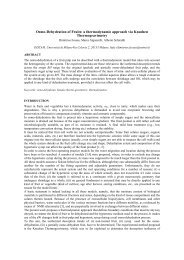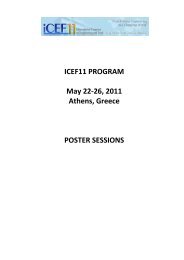The effect of UHT and VAT thermal processing - 11th International ...
The effect of UHT and VAT thermal processing - 11th International ...
The effect of UHT and VAT thermal processing - 11th International ...
You also want an ePaper? Increase the reach of your titles
YUMPU automatically turns print PDFs into web optimized ePapers that Google loves.
gelation <strong>and</strong> protein breakdown in <strong>UHT</strong> processed milks [10]. But the exact mechanism <strong>of</strong> gelation in <strong>UHT</strong><br />
milk is not clearly understood [11].<br />
Sedlmeyer <strong>and</strong> Kulozik [12] investigated the <strong>effect</strong> <strong>of</strong> the heating temperature in the range <strong>of</strong> 120–139°C <strong>and</strong><br />
the filling temperature after cooling down to 4–14°C prior to storage for 24 <strong>and</strong> 96 h at 4 °C on a system<br />
comprising milk <strong>and</strong> 400 ppm kappa-2 type <strong>of</strong> carrageenan. <strong>The</strong> textural properties <strong>and</strong> the stability <strong>of</strong> such<br />
systems mainly depend on the interaction <strong>of</strong> the carrageenan <strong>and</strong> the casein micelle surface which was<br />
assessed by means <strong>of</strong> the hysteresis loop area between the upward <strong>and</strong> downward flow curves upon variation<br />
<strong>of</strong> the shear stress. During storage, a further influence <strong>of</strong> the process parameters on structural development<br />
between casein <strong>and</strong> carrageenan was observed. Structure point analysis, small angle oscillatory rheology <strong>and</strong><br />
particle size measurements were used for further explanation <strong>of</strong> the results <strong>of</strong> the hysteresis loop area.<br />
Studies clearly show that high protein concentration can greatly influence the formation mechanisms <strong>of</strong> whey<br />
protein gels. Fickak et al. [13] used a laboratory produced heat induced whey protein gels (HIWPG) <strong>and</strong> a<br />
pilot plant heat exchanger fouling/cleaning to investigate the <strong>effect</strong> <strong>of</strong> protein concentration on formation <strong>and</strong><br />
cleaning <strong>of</strong> dairy fouling.<br />
<strong>The</strong> Viscolab (Tetra Pak), an indirect ultra-high treatment (<strong>UHT</strong>) pilot plant, was used by Depypere et al.<br />
[14] to prepare dairy desserts containing kappa-carrageenan, skimmed milk powder (SMP), adipate crosslinked<br />
acetyl-substituted waxy maize starch, sucrose <strong>and</strong> water. Effects <strong>of</strong> varying concentrations <strong>of</strong><br />
carrageenan, milk powder <strong>and</strong> starch on the dessert rheology were studied. <strong>The</strong>y found that the dessert<br />
preparation in an <strong>UHT</strong> pilot plant involved a more intense heat treatment. As a result, a more extensive whey<br />
protein denaturation <strong>and</strong> subsequent complexation with casein micelles is believed to contribute to the<br />
rheological properties <strong>of</strong> the <strong>UHT</strong> desserts.<br />
<strong>The</strong>refore, it is <strong>of</strong> interest to determine the degree <strong>of</strong> whey protein denaturation induced by different<br />
<strong>processing</strong> systems <strong>and</strong> the correlation <strong>of</strong> denaturation to the gel strength. <strong>The</strong> current study examines the<br />
<strong>effect</strong> <strong>of</strong> two process systems i.e. continuous <strong>UHT</strong> <strong>and</strong> batch <strong>VAT</strong> heat treatments, on the denaturation <strong>of</strong><br />
whey proteins with a view to further correlation with the mechanism <strong>of</strong> gel strength in yoghurt.<br />
MATERIALS & METHODS<br />
<strong>The</strong>rmal Processing<br />
Raw whole milk was heat treated by two <strong>processing</strong> systems, i.e. a continuous <strong>UHT</strong> <strong>and</strong> a batch <strong>VAT</strong>,<br />
represented by the following temperature-process holding time combinations: <strong>UHT</strong> <strong>processing</strong> at<br />
temperatures 132 0 C to 154 0 C with an app. 6 0 C increment for 0.0, 1.2, 3.3, 5.2, 9.0, <strong>and</strong> 12.0 sec <strong>and</strong> <strong>VAT</strong><br />
<strong>processing</strong> at temperatures 66 0 C to 88 0 C with an app. 6 0 C increment for 0.0, 5.0, 10.o, 20.0, <strong>and</strong> 30 min.<br />
Unheated milk was utilized as a control.<br />
<strong>UHT</strong> <strong>and</strong> <strong>VAT</strong> heat treatments were carried out in a helically coiled tube, with an indirect heating system,<br />
automatic temperature control <strong>and</strong> in a steam jacketed batch type pasteurizer respectively. Different residence<br />
times were obtained by using holding tubes <strong>of</strong> varying length size <strong>and</strong> changing pump speeds in the <strong>UHT</strong><br />
process system. All heat treatments were homogenized at 60 0 C preheating temperature <strong>and</strong> an approximate<br />
105 Kg/cm 2 operating pressure.<br />
Preparation <strong>of</strong> Gel<br />
After homogenization <strong>and</strong> cooling to approx. 43°C, milk was inoculated with 3% mixed yoghurt culture<br />
(Streptococcus thermophilus <strong>and</strong> Lactobacillus bulgaricus at a 1:1 ratio) <strong>and</strong> incubated at 43 0 C until a pH <strong>of</strong><br />
4.5 was obtained (Fig. 1). <strong>The</strong>n, it was stored at refrigeration temperature for further analysis.<br />
Gel Strength Measurements<br />
For relative comparisons between heat treatments <strong>of</strong> the two <strong>processing</strong> systems, yoghurt gels were subjected<br />
to a st<strong>and</strong>ard procedure (one day-old, unstirred 4 0 C yoghurt gel strength measurement). A Cherry-Burrel<br />
curd tension meter was used to measure the strength <strong>of</strong> yoghurt gels. Total breaking energy (gel strength or<br />
curd tension values) was expressed in grams required to penetrate approx. 6 cm deep into the body <strong>of</strong> the<br />
yoghurt gel with a round plunger.<br />
Whey Protein Separation<br />
Diverse heat treated milks <strong>and</strong> the control (unheated) were acidified to pH 4.6 at 35 0 C, centrifuged (1000 x g<br />
15 min, 4 0 C), <strong>and</strong> filtered (Whatman no. 1 paper) to an acid whey solution which was ten-fold concentrated<br />
by treating 10 ml with l.8 g lyphogen medium for 4 hrs prior to electrophoresis. <strong>The</strong> whey proteins were<br />
separated on cellulose acetate strips using the electrophoresis procedure <strong>of</strong> Morr [15] as modified by Bell <strong>and</strong>



